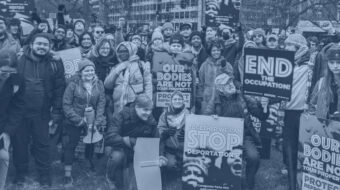Saddam Hussein’s capture answers the question of where he has been since the fall of Baghdad, but there are still many other unanswered questions in Iraq.
Many of these questions relate to civilian deaths among Iraqis during coalition attacks. Shooting incidents involving the U.S. military and Iraqis protesting Saddam Hussein’s capture serve to highlight the continuing danger to civilians.
Human Rights Watch has published a report, entitled “Off Target: The Conduct of the War and Civilian Casualties in Iraq,” which calls into question U.S. military tactics in Iraq.
Among the criticisms, the repeated attempts at so-called “decapitation” strikes on the Iraqi leadership, HRW details 50 such attacks that failed to hit intended targets but killed and wounded many Iraqi civilians. Much was made of the use of “precision” weapons during the “decapitation” attempts, but when faulty intelligence is used as the basis for choosing targets these weapons are every bit as deadly for civilians as less-advanced methods.
Also condemned is the extensive usage of cluster munitions that result in the wide dispersal of unexploded “bomblets,” which then act as landmines. Cluster bomb attacks killed at least 33 civilians and wounded 109 in the Hilla area of Iraq in just one day. In total it is estimated that almost 13,000 cluster munitions, containing in total approximately two million “bomblets,” were used against Iraq.
The HRW report did not attempt to estimate the number of civilian fatalities, but the Associated Press conducted its own survey and estimates that at least 3,420 civilians were killed. The website iraqbodycount.org has its own minimum estimate of civilian deaths: at the time of this article it is at 7,935.
The U.S. military has time and time again repeated retired Gen. Tommy Franks’ assertion that when it comes to civilians, “we don’t do body counts.” With few exceptions, that has been the rule.
Many were awaiting an Iraqi Health Ministry report on civilian deaths that they hoped would provide a more accurate account of the number of Iraqis who have lost their lives. This report now seems to have been suppressed. A Health Ministry official who ran the study has told the Associated Press that she has been ordered to stop her work, and has been forbidden from releasing the statistics she has gathered so far.
Dr. Nagham Mohsen, the head of the ministry’s statistics department, received the order to cease her study through the ministry’s director of planning, who told her that he was relaying the order from the health minister himself.
The health minister claimed not to be aware of any such study, even though it had been ongoing since late July. He wrote to the AP telling them that “It would be almost impossible to conduct such a survey, because hospitals cannot distinguish between deaths that resulted from the coalition’s efforts in the war, common crime among Iraqis, or deaths resulting from Saddam’s brutal regime,” a view that Dr. Mohsen does not share.
Dr. Mohsen is convinced that the effort to suppress the death statistics she had managed to compile came directly from the U.S.-led Coalition Provisional Authority, telling the Associated Press: “The CPA doesn’t want this to be done.”
Without the release of the Health Ministry’s more comprehensive statistics, it seems that the full story of Iraq’s civilian deaths may never be told.
The author can be reached at pww@pww.org.









